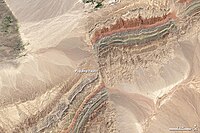
Photo from wikipedia
Abstract We characterize a deep-water fold-thrust arrays imaged by a high-resolution 3D seismic dataset in the offshore NW Borneo, Malaysia, to understand the kinematics behind spatial arrangement of structural variations… Click to show full abstract
Abstract We characterize a deep-water fold-thrust arrays imaged by a high-resolution 3D seismic dataset in the offshore NW Borneo, Malaysia, to understand the kinematics behind spatial arrangement of structural variations throughout the fold-thrust system. The seismic volume used covers two sub-parallel fold trains associated with a series of fore-thrusts and back-thrusts. We measured fault heave, shortening value, fold geometries (forelimb dip, interlimb angle and crest depth) along strike in individual fold trains. Heave plot on strike projection allows to identify individual thrust segments showing semi-elliptical to triangular to bimodal patterns, and linkages of these segments. The linkage sites are marked by local minima in cumulative heave. These local heave minima are compensated by additional structures, such as small imbricate thrusts and tight folds indicated by large forelimb dip and small interlimb angle. Complementary profiles of the shortening amount for the two fold trains result in smoother gradient of total shortening across the structures. We interpret this reflects kinematic interaction between two fold-thrust trains. This type of along-strike variation analysis provides comprehensive understanding of a fold-thrust system and may provide an interpretative strategy for inferring the presence of complex multiple faults in less well-imaged parts of seismic volumes.
Journal Title: Journal of Structural Geology
Year Published: 2017
Link to full text (if available)
Share on Social Media: Sign Up to like & get
recommendations!